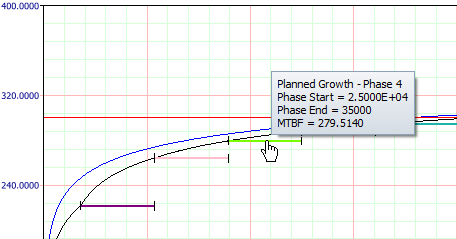

| Related Topics: | ||
After you have used the Data sheet in the growth planning folio to create a reliability growth program test plan, you can use the Plot sheet to view a variety of plots that show the results that are expected if you implement the plan.
To view the growth planning folio plots, choose Growth Planning > Analysis > Plot or click the icon on the control panel.
![]()
This section describes the types of plots you can create for growth planning. The scaling, setup, exporting and confidence bounds settings are similar to the options available for all other RGA plot sheets. For more information on these common options, see Plots.
The following plot types are available.
The MTBF vs. Time and Failure Intensity vs. Time plots show the expected mean time between failures and failure intensity across all planned test phases. You can use the Show area of the control panel to select which of the following elements will be displayed in the plot:
The Nominal Idealized and Actual Idealized lines (also called idealized growth curves) show the overall characteristic pattern for the reliability growth across all phases of testing.
The nominal MTBF/FI is the best case scenario, which assumes that the average fix delay is zero.
The actual MTBF/FI takes into account the average fix delay. If fixes are not incorporated instantaneously, the actual line will show slower growth compared to the nominal line.
The Planned Growth lines display information for each phase of testing (and thus are available only when you provided information for each phase). These horizontal lines mark the time when each phase will begin and end, while the vertical position of each line shows the expected MTBF or failure intensity at the beginning of the phase. You can point to the line to see the specific values.
For example, the following picture highlights the planned growth interval for the fourth phase of a multi-phase test plan. The phase begins at 25,000 hours and ends at 35,000 hours of test time. The MTBF at the start of the test phase is estimated to be 279.514 hours.

Note that, unlike the other plots, you can show confidence bounds on the planned growth lines, but only when you have at least 3 test phases specified on the folio's Data sheet.
The Termination Line shows the end time of the final test phase.
The Goal line shows the target MTBF or failure intensity that you hope to achieve by the last phase of testing.
Cumulative Number of B Modes shows the cumulative number of observed unique B failure modes versus time. These are failure modes that have been discovered and will be fixed.
MTBF B Unseen shows the mean time between failures due to B failure modes that have not yet appeared in testing. These are failure modes that are anticipated based on the analysis and will be fixed when/if they are discovered.
Discovery Rate shows the rate at which unique B failure modes are being discovered. In other words, it is the failure intensity of the failure modes that will be fixed.
© 1992-2015. ReliaSoft Corporation. ALL RIGHTS RESERVED.